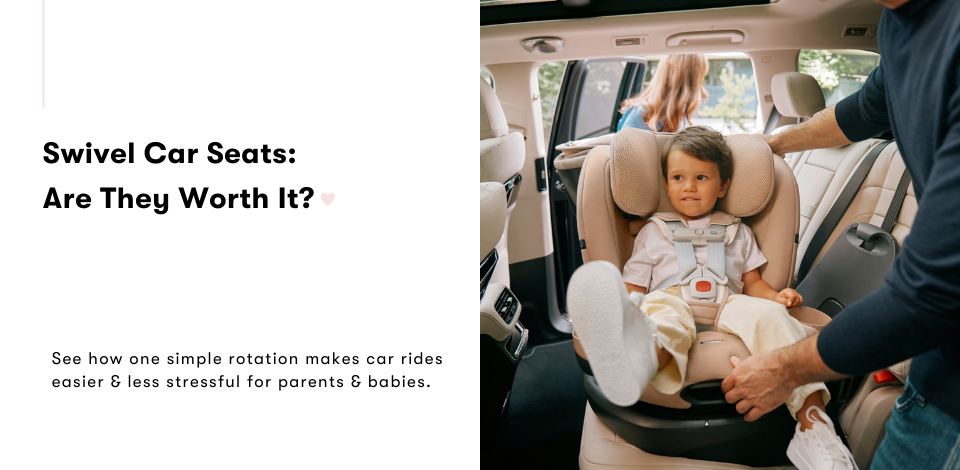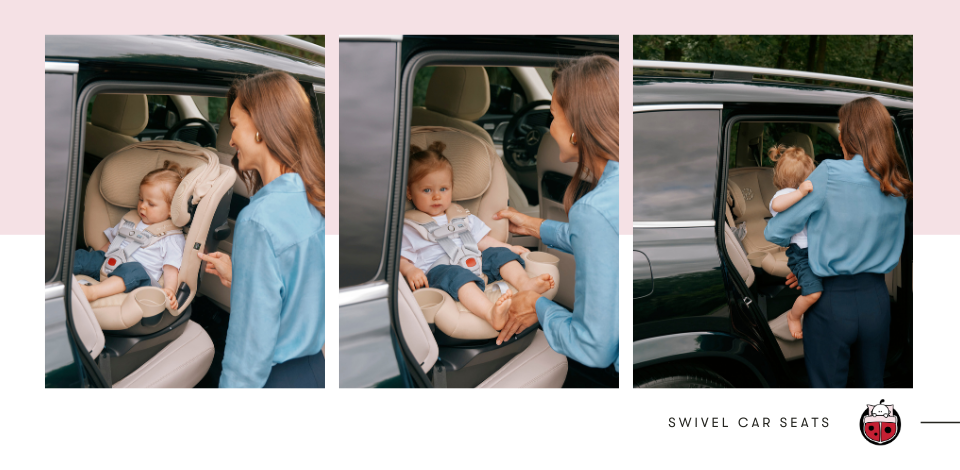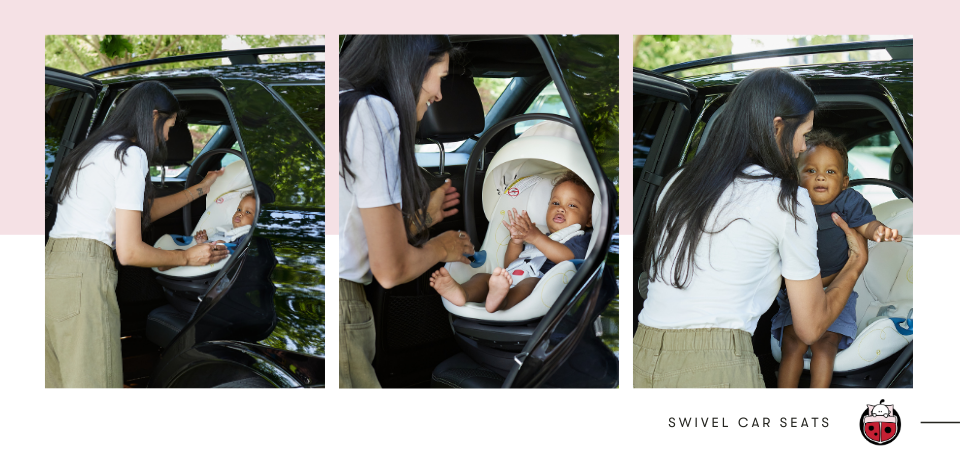Swivel Car Seats: Are They Worth It?
Jump to Section

Choosing a car seat for your little one is no small feat. With so many options available, from infant seats to convertibles, rear-facing to forward-facing, it’s easy to feel overwhelmed. One feature that has been gaining attention in recent years is the swivel car seat.
These seats promise easier access, safer installs, and smoother transitions as your child grows. But are they really worth the hype? Let’s break it down.
What is a Swivel Car Seat?
A swivel car seat, sometimes called a rotating car seat, is designed to rotate 90° (and sometimes 180°) toward the car door. This means instead of awkwardly reaching over your child or twisting your body to buckle them in, you can swing the seat toward you for a more convenient and comfortable experience.
Most swivel seats offer 360° rotation, allowing you to switch between rear-facing, forward-facing, and even booster modes without removing the seat from your vehicle. They are typically found in convertible car seats, which are built to grow with your child from infancy to toddlerhood and sometimes beyond.
The Benefits of a Swivel Car Seat
Swivel car seats are more than just a neat gadget, they provide real-life convenience and safety benefits.
1. Easier Access for Parents
One of the biggest challenges for new parents is loading and unloading a baby or toddler from a car seat, especially in smaller vehicles. Swivel seats allow the car seat to rotate toward the car door, which can save your back, shoulders, and arms from awkward bending and twisting.
For parents with mobility issues, or even those juggling multiple kids or groceries, this feature can be a game-changer. You can comfortably buckle and unbuckle your child without leaning over the seat or twisting into awkward positions.
2. Safer Car Seat Installations
Swivel seats often come with enhanced safety features that complement the rotation mechanism. Features like Load Legs, Anti-Rebound Bars, and SensorSafe technology (in Cybex car seats) are commonly included in these models.
-
Load Leg: This stabilizes the seat, reducing forward movement in a collision.
-
Anti-Rebound Bar: Absorbs energy in rear-facing mode to prevent rebound toward the car seat.
-
SensorSafe Technology: Alerts parents if the harness is unbuckled or the child is too warm or left in the seat.
By combining these safety features with easier access, swivel seats make it simpler for parents to properly secure the seat and harness, which is critical for protecting your child in a crash.
3. Longer Rear-Facing Use
Most swivel car seats allow extended rear-facing, which is highly recommended for safety. Experts suggest keeping children rear-facing until at least age two, or until they reach the seat’s maximum rear-facing height and weight limit.
The rotation feature makes rear-facing mode more accessible, so you’re more likely to use it correctly and consistently. This helps reduce the risk of injury in a collision, as rear-facing seats distribute crash forces more evenly across the child’s body.
4. Smooth Transition to Forward-Facing
As your child grows, switching from rear-facing to forward-facing can be a bit of a workout, especially for taller toddlers. Swivel seats allow the seat to rotate, making it much easier to adjust the harness, reposition your child, and ensure the seat is installed correctly.
No more wrestling with a squirmy toddler while trying to pull the seat forward, it’s simply a matter of rotating the seat and buckling them in comfortably.
5. Convenience in Tight Parking Spaces
Swivel car seats are particularly helpful for parents who live in urban areas with tight parking lots or parallel street parking. By rotating the seat toward the car door, you reduce the risk of bumping your child against car doors, walls, or other obstacles while loading or unloading.
Even parents of larger vehicles or SUVs can benefit, especially when multiple kids need to be loaded quickly in busy areas.

Potential Drawbacks of Swivel Car Seats
While swivel seats sound amazing, there are some things to consider before investing.
1. Price Point
Swivel car seats are generally more expensive than traditional infant and convertible seats. While you’re paying for convenience, extended usability, and advanced features, the cost can be a deciding factor for families on a budget.
Expect to spend a few hundred dollars more for a quality swivel model, though many parents find the long-term convenience and safety benefits justify the expense.
2. Weight and Size
Because of the rotation mechanism, swivel seats are often bulkier and heavier than traditional seats. This can make moving the seat between cars or storing it more challenging. If you frequently travel, carpool, or have a small vehicle, this is worth considering.
3. Learning Curve
Swivel car seats require parents to understand how to properly rotate and lock the seat in each position. While most seats come with clear instructions, new parents may need a few tries to feel confident in using the rotation feature safely.
Improper locking can compromise safety, so it’s crucial to read the manual thoroughly and double-check each installation.
4. Limited Models
While the swivel car seat market is growing, there are still fewer options compared to traditional car seats. You may have to compromise on colour, style, or additional features to get a swivel seat that fits your vehicle and meets your budget.
Are Swivel Car Seats Really Worth It?
Ultimately, whether a swivel car seat is worth it depends on your lifestyle, vehicle, and parenting needs.
You might love a swivel seat if you:
-
Have limited mobility or struggle with bending and twisting.
-
Frequently load and unload your child in tight parking spaces.
-
Want to maximize rear-facing use safely and conveniently.
-
Value convenience when transitioning your child from rear-facing to forward-facing.
-
Are willing to invest in a slightly more expensive seat for long-term usability.

You might skip a swivel seat if you:
-
Have a tight budget and can manage traditional car seats.
-
Need a lightweight, portable seat for travel or multiple vehicles.
-
Prefer a simpler design without additional moving parts.
In general, swivel car seats shine in convenience and safety, especially for everyday city living or busy parents. Many parents find that the reduced strain on their back, the smoother harnessing process, and the added safety features make swivel seats a worthwhile investment.
Tips for Using a Swivel Car Seat Safely
-
Read the Manual Thoroughly: Every seat has its own rotation and locking mechanisms. Follow the instructions to ensure correct installation.
-
Check Vehicle Compatibility: Some cars have limited space between the seat and door. Visit a local Snuggle Bugz location to test the car seat in your vehicle to ensure proper fit.
-
Lock Before Driving: Always make sure the seat is in its forward-facing or rear-facing position and fully locked before hitting the road.
-
Use Recommended Harness Heights: Keep your child properly positioned in the harness according to manufacturer guidelines.
-
Take Advantage of Rear-Facing Longer: Use the swivel feature to maximize the rear-facing stage, which is the safest orientation for your child.
Final Thoughts
Swivel car seats are a game-changer for convenience, safety, and everyday parenting. They reduce the strain of loading and unloading, make harnessing easier, and encourage longer rear-facing, which is critical for your child’s safety. While they come with a higher price tag and some size considerations, many parents find the benefits outweigh the drawbacks.
If you’re looking for a car seat that combines versatility, safety, and convenience, a swivel car seat is definitely worth considering. Your back, and your sanity, will thank you.





